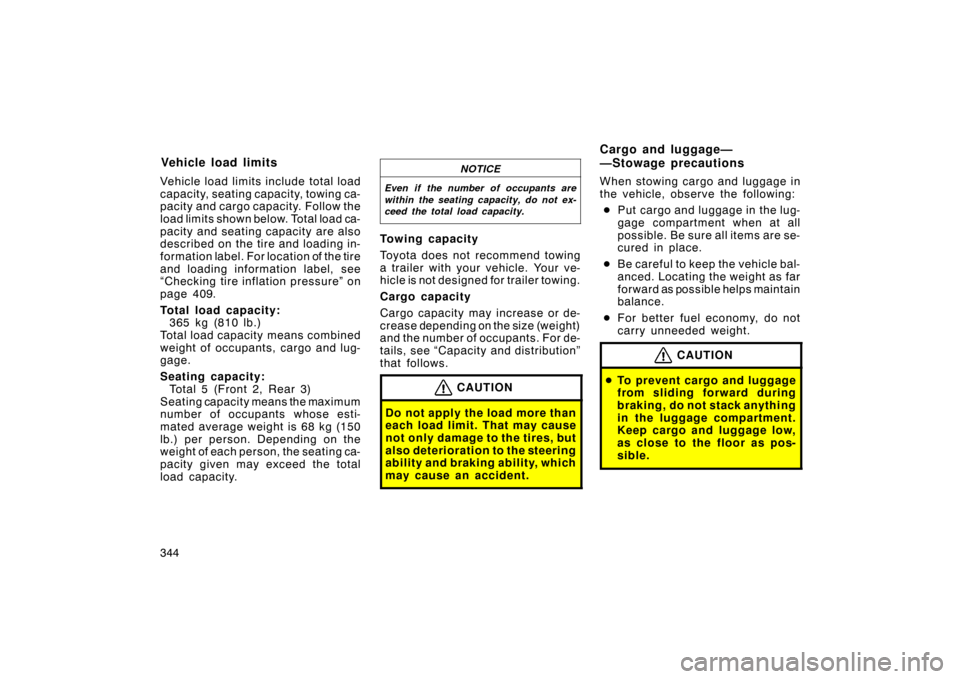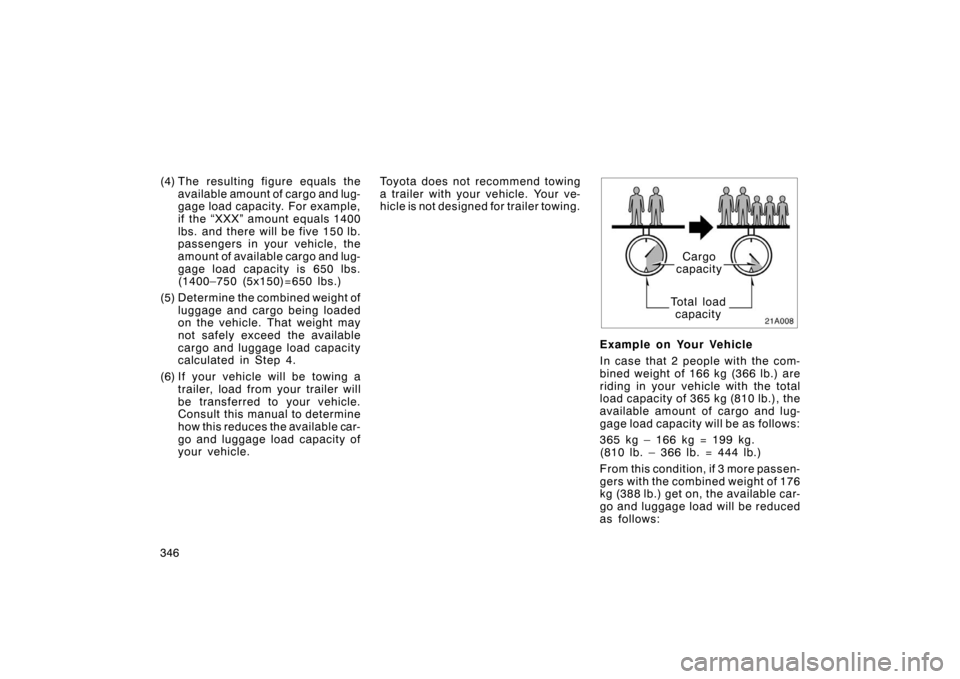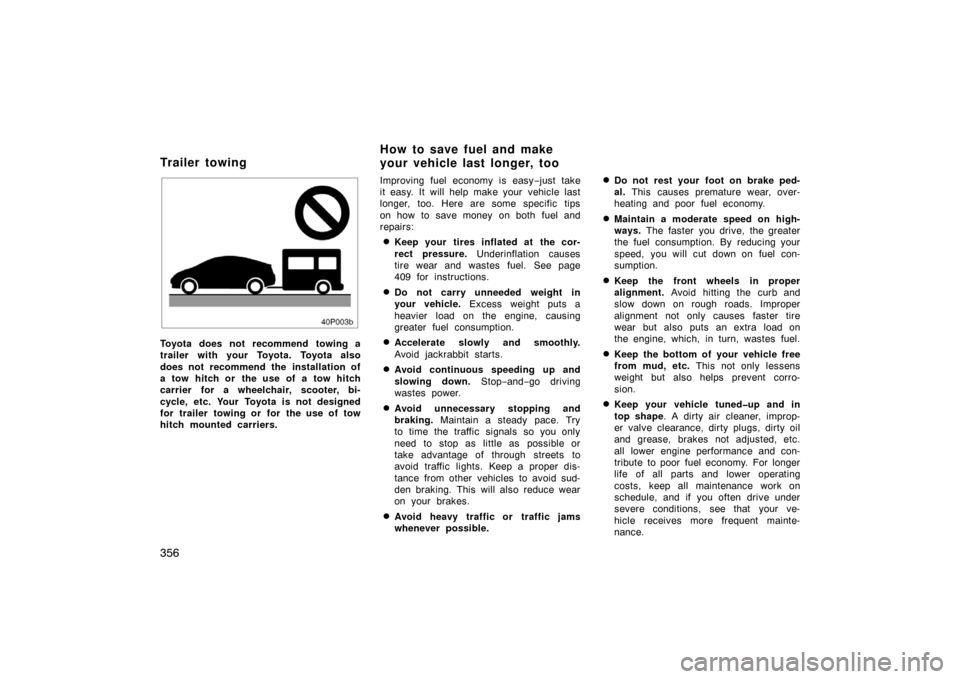Page 344 of 458

344 Vehicle load limits include total load
capacity, seating capacity, towing ca-
pacity and cargo capacity. Follow the
load limits shown below. Total load ca-
pacity and seating capacity are also
described on the tire and loading in-
formation label. For location of the tire
and loading information label, see
“Checking tire inflat ion pr es s ur e” on
page 409.
Total load capacity:
365 kg (810 lb.)
Total load capacity means combined
weight of occupants, cargo and lug-
gage.
Seating capacity: Total 5 (Front 2, Rear 3)
Seating capacity means the maximum
number of occupants whose esti-
mated average weight is 68 kg (150
lb.) per person. Depending on the
weight of each person, the seating ca-
pacity given may exceed the total
load capacity.
NOTICE
Even if the number of occupants are
within the seating capacity, do not ex-
ceed the total load capacity.
Towing capacity
Toyota does not recommend towing
a trailer with your vehicle. Your ve-
hicle is not designed for trailer towing.
Cargo capacity
Cargo capacity may increase or de-
crease depending on the size (weight)
and the number of occupants. For de-
tails, see “Capacity and distribution”
that follows.
CAUTION
Do not apply the load more than
each load limit. That may cause
not only damage to the tires, but
also deterioration to the steering
ability and braking ability, which
may cause an accident.
When stowing cargo and luggage in
the vehicle, observe the following:
� Put cargo and luggage in the lug-
gage compartment when at all
possible. Be sure all items are se-
cured in place.
� Be careful to keep the vehicle bal-
anced. Locating the weight as far
forward as possible helps maintain
balance.
� For better fuel economy, do not
carry unneeded weight.
CAUTION
�To prevent cargo and l uggage
from sliding forward during
braking, do not stack anything
in the luggage compartment.
Keep cargo and luggage low,
as close to the floor as pos-
sible.
Vehicle load limits Cargo and luggage—
—Stowage precautions
Page 346 of 458

346 (4) The resulting figure equals theavailable amount of cargo and lug-
gage load capacity. For example,
if the “XXX” am ount equals 1400
lbs. and there will be five 150 lb.
passengers in your vehicle, the
amount of available cargo and lug-
gage load capacity is 650 lbs.
(1400–750 (5x150)=650 lbs.)
(5) Determine the combined weight of luggage and cargo being loaded
on the vehicle. That weight may
not safely exceed the available
cargo and luggage load capacity
calculated in Step 4.
(6) If your vehicle will be towing a trailer, load from your trailer will
be transferred to your vehicle.
Consult this manual to determine
how this reduces the available car-
go and luggage load capacity of
your vehicle. Toyota does not recommend towing
a trailer with your vehicle. Your ve-
hicle is not designed for trailer towing.
Total load
capacity Cargo
capacity
Example on Your Vehicle
In case that 2 people with the com-
bined weight of 166 kg (366 lb.) are
riding in your vehicle with the total
load capacity of 365 kg (810 lb.), the
available amount of cargo and lug-
gage load capacity will be as follows:
365 kg – 166 kg = 199 kg.
( 810 lb. – 366 lb. = 444 lb. )
From this condition, if 3 more passen-
gers with the combined weight of 176
kg (388 lb.) get on , the av ailable car-
go and luggage load will be reduced
as follows:
Page 349 of 458
349
STARTING AND DRIVING
Starting and driving
Before starting the hybrid system350
. . . . . . . . . . . . . . . . . . . . . . . . . . . . .
How to start the hybrid system 350
. . . . . . . . . . . . . . . . . . . . . . . . . . . . . . .
Tips for driving in various conditions 352
. . . . . . . . . . . . . . . . . . . . . . . . . .
Driving in the rain 353
. . . . . . . . . . . . . . . . . . . . . . . . . . . . . . . . . . . . \
. . . . . . .
Winter driving tips 354
. . . . . . . . . . . . . . . . . . . . . . . . . . . . . . . . . . . . \
. . . . . .
Dinghy towing 355
. . . . . . . . . . . . . . . . . . . . . . . . . . . . . . . . . . . . \
. . . . . . . . . .
Trailer towing 356
. . . . . . . . . . . . . . . . . . . . . . . . . . . . . . . . . . . . \
. . . . . . . . . .
How to save fuel and make your vehicle last longer, too 356
. . . . . . . . .
SECTION 4
Page 356 of 458

356
40p003b
Toyota does not recommend towing a
trailer with your Toyota. Toyota also
does not recommend the installation of
a tow hitch or the use of a tow hitch
carrier for a wheelchair, scooter, bi-
cycle, etc. Your Toyota is not designed
for trailer towing or for the use of tow
hitch mounted carriers.Improving fuel economy is easy
−just take
it easy. It will help make your vehicle last
longer, too. Here are some specific tips
on how to save money on both fuel and
repairs:
�Keep your tires inflated at the cor-
rect pressure. Underinflation causes
tire wear and wastes fuel. See page
409 for instructions.
�Do not carry unneeded weight in
your vehicle. Excess weight puts a
heavier load on the engine, causing
greater fuel consumption.
�Accelerate slowly and smoothly.
Avoid jackrabbit starts.
�Avoid continuous speeding up and
slowing down. Stop−and− go driving
wastes power.
�Avoid unnecessary stopping and
braking. Maintain a steady pace. Try
to time the traffic signals so you only
need to stop as little as possible or
take advantage of through streets to
avoid traffic lights. Keep a proper dis-
tance from other vehicles to avoid sud-
den braking. This will also reduce wear
on your brakes.
�Avoid heavy traffic or traffic jams
whenever possible.
�Do not rest your foot on brake ped-
al. This causes premature wear, over-
heating and poor fuel economy.
�Maintain a moderate speed on high-
ways. The faster you drive, the greater
the fuel consumption. By reducing your
speed, you will cut down on fuel con-
sumption.
�Keep the front wheels in proper
alignment. Avoid hitting the curb and
slow down on rough roads. Improper
alignment not only causes faster tire
wear but also puts an extra load on
the engine, which, in turn, wastes fuel.
�Keep the bottom of your vehicle free
from mud, etc. This not only lessens
weight but also helps prevent corro-
sion.
�Keep your vehicle tuned�up and in
top shape . A dirty air cleaner, improp-
er valve clearance, dirty plugs, dirty oil
and grease, brakes not adjusted, etc.
all lower engine performance and con-
tribute to poor fuel economy. For longer
life of all parts and lower operating
costs, keep all maintenance work on
schedule, and if you often drive under
severe conditions, see that your ve-
hicle receives more frequent mainte-
nance.
Trailer towing How to save fuel and make
your vehicle last longer, too